A New Control Strategy for Energy Management of Bidirectional Chargers for Electric Vehicles to Minimize Peak Load in Low-Voltage Grids with PV Generation
Abstract
1. Introduction
- A new V2G application predicts EV charging/discharging profiles using C++ programming language and the Qt toolkit [25]. The main contribution of this paper is that the proposed application takes into account all of the previously mentioned factors while employing various scheduling strategies for EV charging/discharging to satisfy the needs of EV owners and the power grid.
- Grid analyses are carried out in DIgSILENT PowerFactory [26] utilizing the Quasi-Dynamic Simulations toolbox to assess the V2G method’s effects on a part of a LV network.
2. Materials and Methods
2.1. PV System
2.1.1. Aleo S77.190
2.1.2. c-Si M 48 M180
2.1.3. Active Power Output of a PV System
2.2. The V2G Scheduling System
- The proposed V2G application forecasts the EVs charging/discharging profiles, utilizing the C++ programming language and the Qt toolkit. This application addresses a variety of topics, including:
- The possibility of controlling the charging start time by grid operator;
- Simulating user’s diverse behaviors through distribution random functions;
- The mobile application, which connects users to the grid operators and the V2G chargers by allowing them to define their desired departure time and SOC levels;
- If PVs are available, they can be used to charge EVs directly.
- The software application DIgSILENT PowerFactory for assessing the distribution network.
2.2.1. V2G Application—Data Collection
- User information;
- Grid and grid operator;
- Household and commercial load database based on BDEW (German Association of Energy and Water Industries) standard for working days, Saturday, and Sunday;
- PV database;
- Simulation time period.
2.2.2. V2G Procedure
Charging and Discharging Scheduling Strategy
- The time difference between and end of peak hour () is equal to or less than ;
- User arrives before with a SOC equal to or less than mobile app’s minimum SOC level ();
- User arrives after .
- At grid operator’s charging start time () (Section 2.2.1): if > .
- At if > .
- At : if .
Charging and Discharging Processes
2.3. Impact on LV Network
2.3.1. Voltage Constraint
2.3.2. Thermal Loading Constraint
3. Results
3.1. Proposed Test System
3.2. Case Studies and Results
4. Conclusions
Author Contributions
Funding
Data Availability Statement
Conflicts of Interest
References
- The German Federal Government. Intergenerational Contract for the Climate. Available online: https://www.bundesregierung.de/breg-de/themen/klimaschutz/climate-change-act-2021-1936846 (accessed on 20 October 2022).
- German Federal Environment Ministry and the Federal Environment Agency. Greenhouse Gas Emissions Fell 8.7 Percent in 2020. Available online: https://www.bmuv.de/pressemitteilung/treibhausgasemissionen-sinken-2020-um-87-prozent (accessed on 20 October 2022).
- The Federal Ministry for Economic Affairs and Energy. Regulatory Environment and Incentives for Using Electric Vehicles and Developing a Charging Infrastructure. Available online: https://www.bmwk.de/Redaktion/EN/Artikel/Industry/regulatory-environment-and-incentives-for-using-electric-vehicles.html (accessed on 20 October 2022).
- The Federal Ministry for Economic Affairs and Energy. Electromobility in Germany. Available online: https://www.bmwk.de/Redaktion/DE/Dossier/elektromobilitaet.html (accessed on 20 October 2022).
- Mohagheghi, E.; Gasso, J.G.; Li, P. Optimal integration of electric vehicles in smart grids with renewables and battery storage systems under uncertainty. Trends Comput. Sci. Inf. Technol. 2020, 5, 048–049. [Google Scholar] [CrossRef]
- Mohammad, A.; Zamora, R.; Lie, T.T. Integration of electric vehicles in the distribution network: A review of PV based electric vehicle modelling. Energies 2020, 13, 4541. [Google Scholar] [CrossRef]
- Kempton, W.; Tomić, J. Vehicle-to-grid power fundamentals: Calculating capacity and net revenue. J. Power Sources 2005, 144, 268–279. [Google Scholar] [CrossRef]
- Vayá, M.G.; Andersson, G. Self scheduling of plug-in electric vehicle aggregator to provide balancing services for wind power. IEEE Trans. Sustain. Energy 2015, 7, 886–899. [Google Scholar] [CrossRef]
- Yilmaz, M.; Krein, P.T. Review of benefits and challenges of vehicle-to-grid technology. In Proceedings of the 2012 IEEE Energy Conversion Congress and Exposition (ECCE), Raleigh, NC, USA, 15–20 September 2012; pp. 3082–3089. [Google Scholar] [CrossRef]
- Kisacikoglu, M.C.; Ozpineci, B.; Tolbert, L.M. Examination of a PHEV bidirectional charger system for V2G reactive power compensation. In Proceedings of the 2010 Twenty-Fifth Annual IEEE Applied Power Electronics Conference and Exposition (APEC), Palm Springs, CA, USA, 21–25 February 2010; pp. 458–465. [Google Scholar] [CrossRef]
- Shi, L.; Lv, T.; Wang, Y. Vehicle-to-grid service development logic and management formulation. J. Modern Power Syst. Clean Energy 2019, 7, 935–947. [Google Scholar] [CrossRef]
- Han, S.; Han, S. Development of short-term reliability criterion for frequency regulation under high penetration of wind power with vehicle-to-grid support. Electr. Power Syst. Res. 2014, 107, 258–267. [Google Scholar] [CrossRef]
- Pavić, I.; Capuder, T.; Kuzle, I. Value of flexible electric vehicles in providing spinning reserve services. Appl. Energy 2015, 157, 60–74. [Google Scholar] [CrossRef]
- Habib, H.U.R.; Subramaniam, U.; Waqar, A.; Farhan, B.S.; Kotb, K.M.; Wang, S. Energy cost optimization of hybrid renewables based V2G microgrid considering multi objective function by using artificial bee colony optimization. IEEE Access 2020, 8, 62076–62093. [Google Scholar] [CrossRef]
- Drude, L.; Junior, L.C.P.; Rüther, R. Photovoltaics (PV) and electric vehicle-to-grid (V2G) strategies for peak demand reduction in urban regions in Brazil in a smart grid environment. Renew. Energy 2014, 68, 443–451. [Google Scholar] [CrossRef]
- Tabatabaee, S.; Mortazavi, S.S.; Niknam, T. Stochastic scheduling of local distribution systems considering high penetration of plug-in electric vehicles and renewable energy sources. Energy 2017, 121, 480–490. [Google Scholar] [CrossRef]
- Slama, S.A.B. Design and implementation of home energy management system using vehicle to home (H2V) approach. J. Clean. Prod. 2021, 312, 127792. [Google Scholar] [CrossRef]
- Sheng, S.W.; Yee, Y.S.; Raymond, W.J.K.; Mei, K.T. Economic Dispatch of Micro-grid Considering Electric Vehicles. In Proceedings of the 2021 11th IEEE International Conference on Control System, Computing and Engineering (ICCSCE), Penang, Malaysia, 27–28 August 2021; pp. 66–70. [Google Scholar] [CrossRef]
- Sabzehgar, R.; Kazemi, M.A.; Rasouli, M.; Fajri, P. Cost optimization and reliability assessment of a microgrid with large-scale plug-in electric vehicles participating in demand response programs. Int. J. Green Energy 2020, 17, 127–136. [Google Scholar] [CrossRef]
- Alsharif, A.; Tan, C.W.; Ayop, R.; Lau, K.Y.; Moh’d Dobi, A. A rule-based power management strategy for Vehicle-to-Grid system using antlion sizing optimization. J. Energy Storage 2021, 41, 102913. [Google Scholar] [CrossRef]
- Bampoulas, A.; Karlis, A. Real-time energy storage management system of a nanogrid integrating photovoltaics and V2G operation. J. Eng. 2019, 2020, 32–40. [Google Scholar] [CrossRef]
- Van Der Kam, M.; van Sark, W. Smart charging of electric vehicles with photovoltaic power and vehicle-to-grid technology in a microgrid; a case study. Appl. Energy 2015, 152, 20–30. [Google Scholar] [CrossRef]
- Harrabi, I.; Maier, M. Performance analysis of a real-time decentralized algorithm for coordinated PEV charging at home and workplace with PV solar panel integration. In Proceedings of the 2014 IEEE PES General Meeting|Conference & Exposition, National Harbor, MD, USA, 27–31 July 2014; pp. 1–5. [Google Scholar] [CrossRef]
- Acharige, S.S.; Haque, M.E.; Arif, M.T.; Hosseinzadeh, N.; Saha, S. A Solar PV Based Smart EV Charging System with V2G Operation for Grid Support. In Proceedings of the 2021 31st Australasian Universities Power Engineering Conference (AUPEC), Perth, Australia, 26–30 September 2021; pp. 1–6. [Google Scholar] [CrossRef]
- Qt Creator, Version 4.11.1. Based on Qt 5.14.1 (MSVC 2017, 32 bit). The Qt Company: Espoo, Finland, 2020.
- DIgSILENT PowerFactory, Version 2019; DIgSILENT GmbH: Gomaringen, Germany, 2018.
- DIgSILENT PowerFactory 2019 Technical Reference PV System (ElmPvsys, TypPvpanel); DIgSILENT GmbH: Gomaringen, Germany, 2019; pp. 1–18. Available online: https://www.digsilent.de/en/newsreader/powerfactory-2019-release.html (accessed on 20 October 2022).
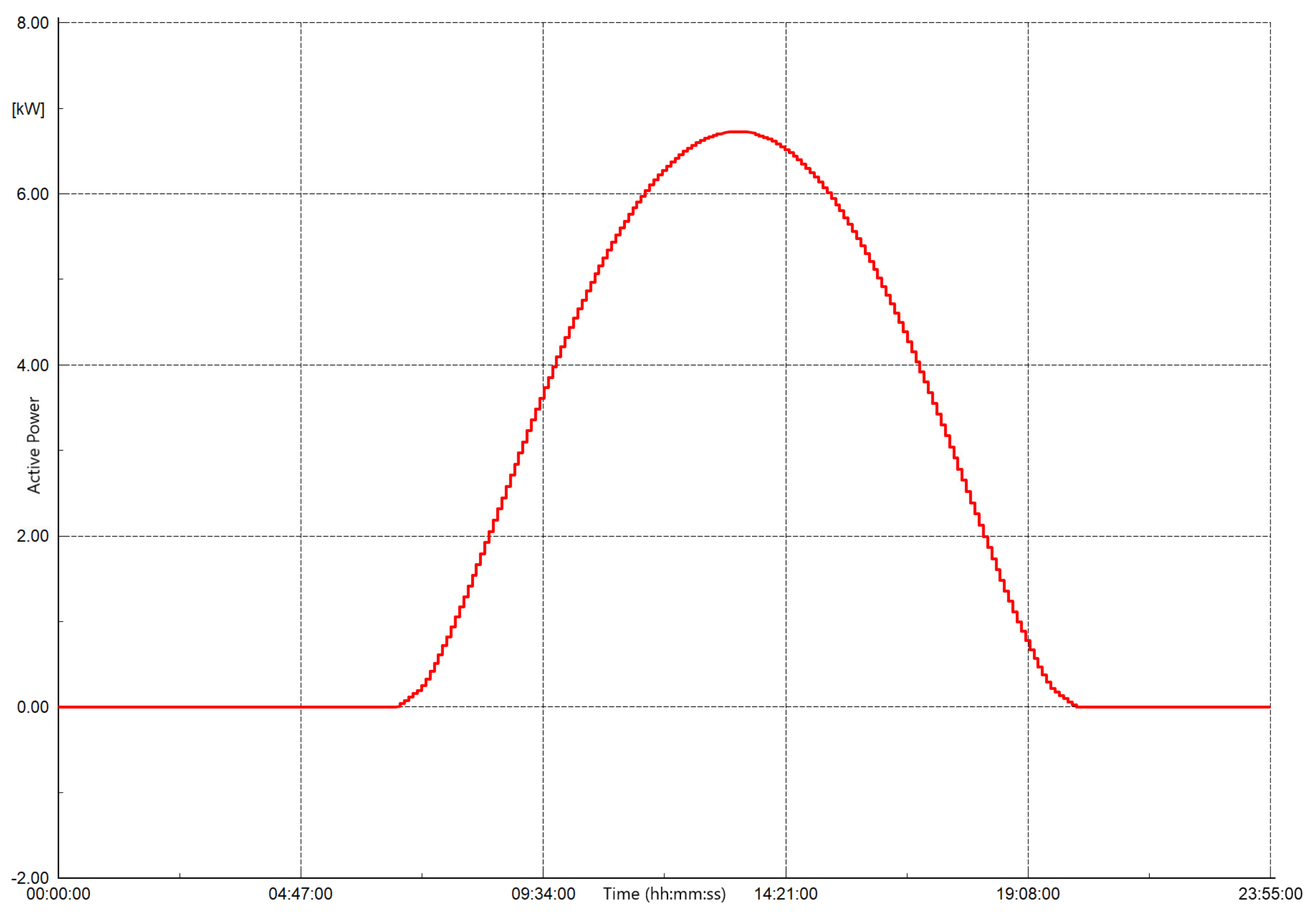
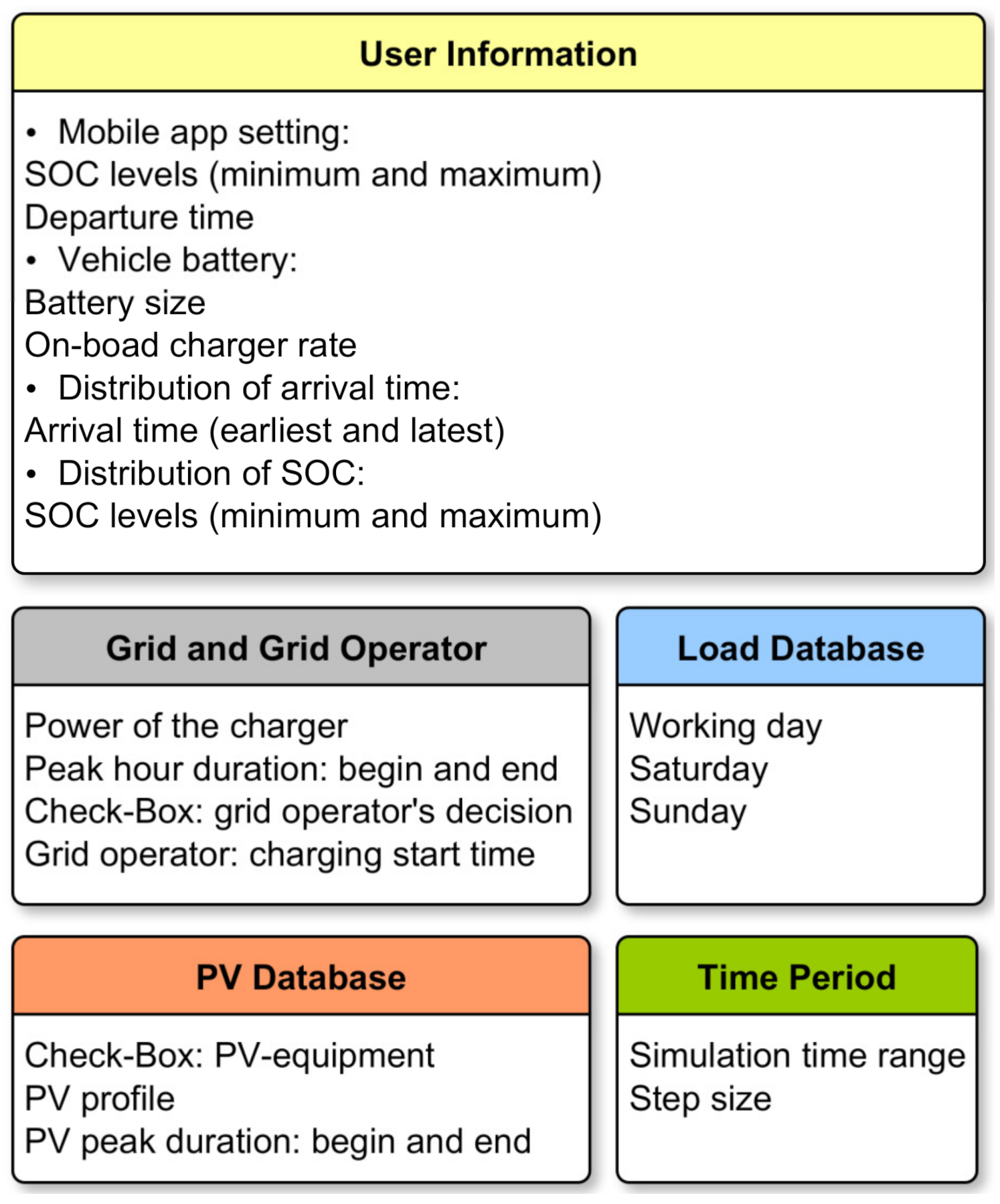

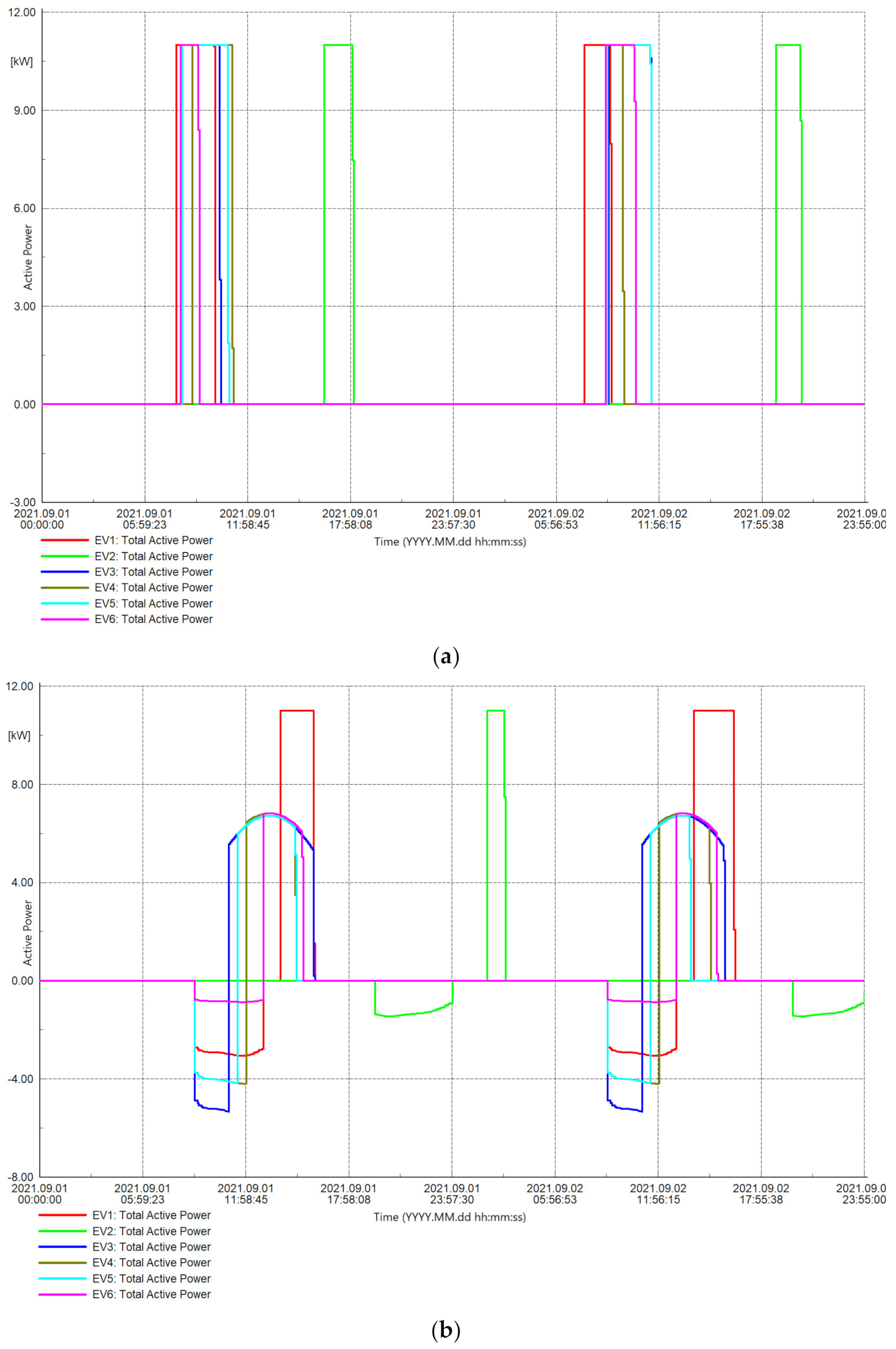
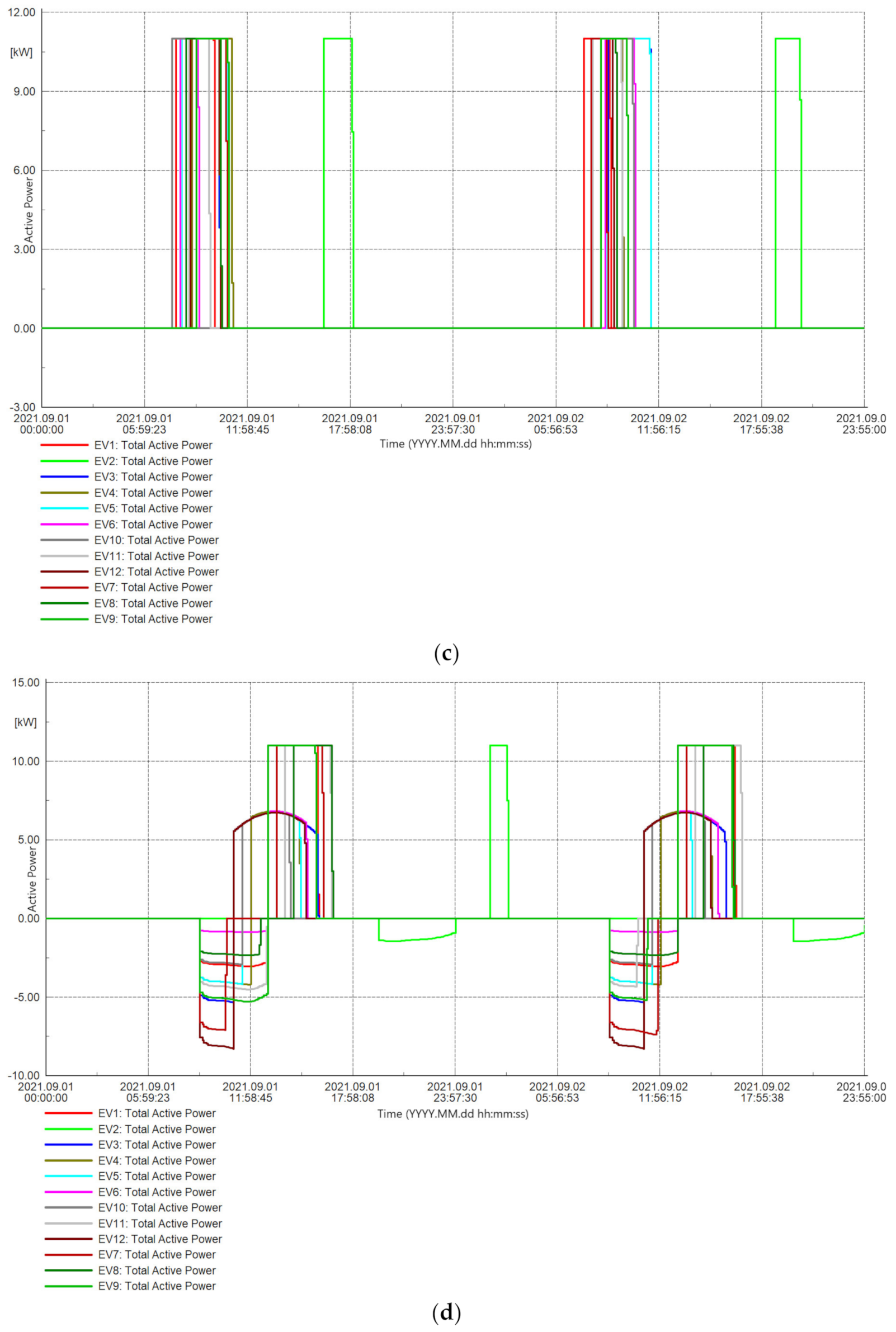
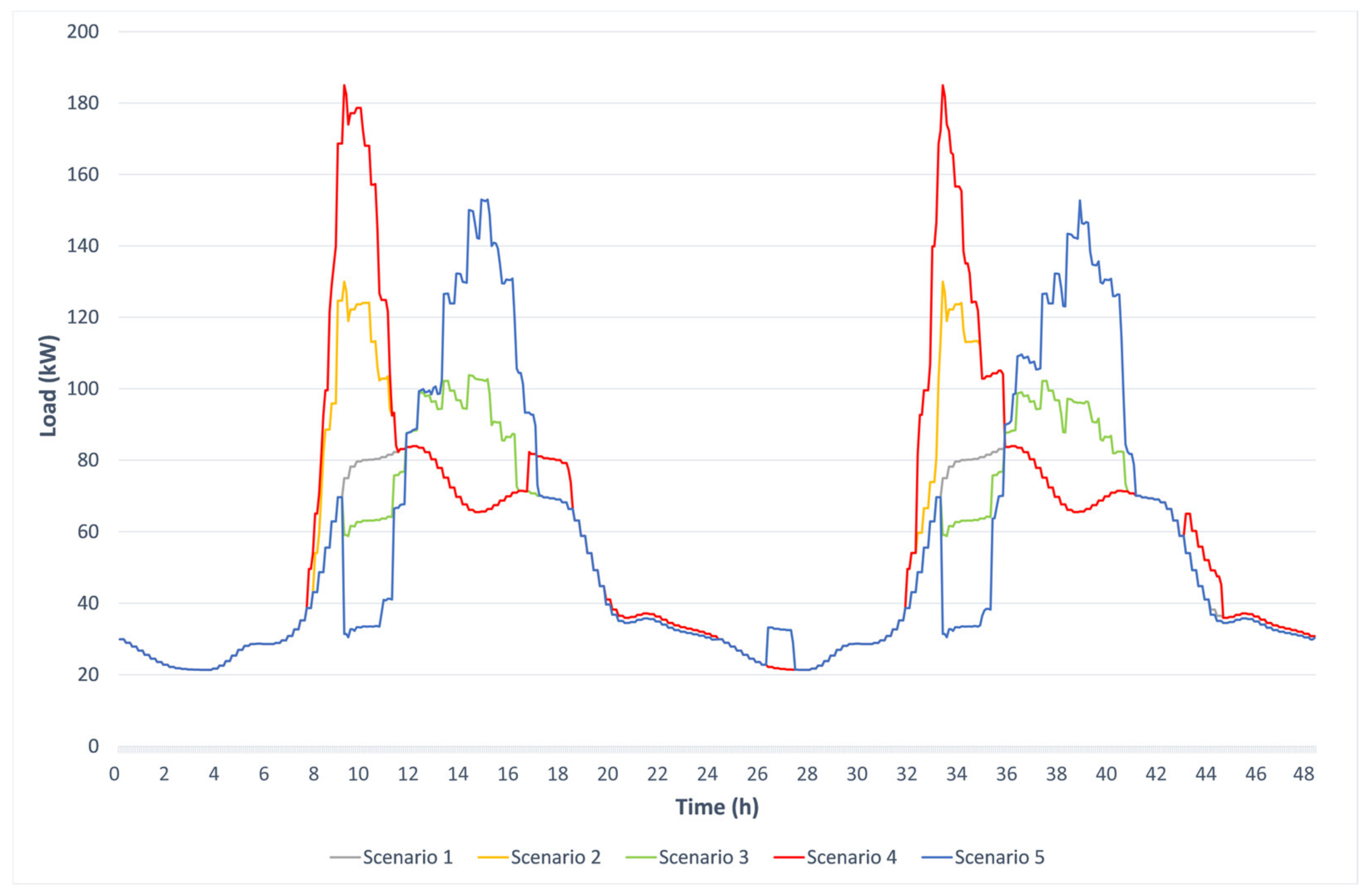
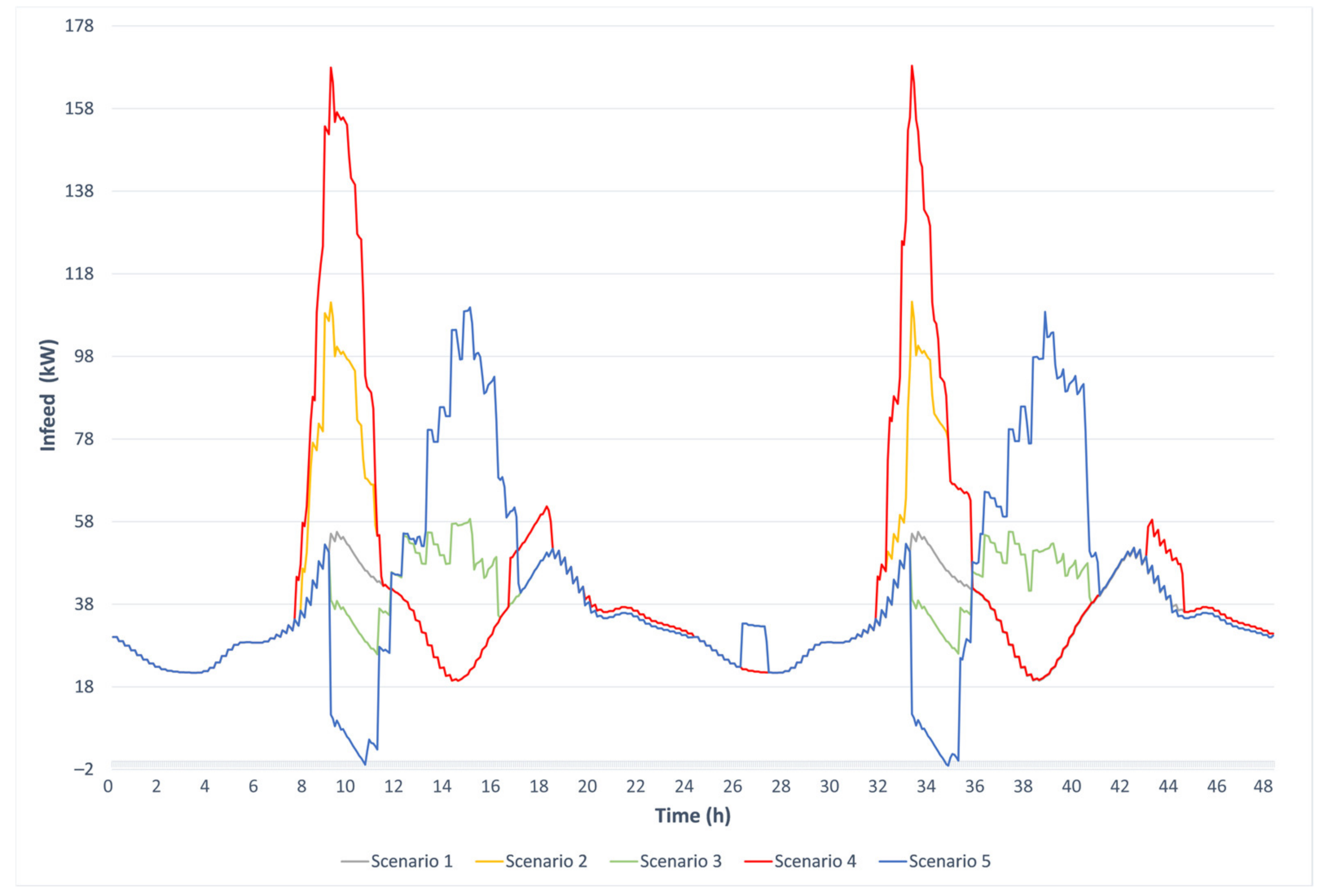
| Parameter | Value |
|---|---|
| 11 kW | |
| 50, 60, and 70 kWh | |
| 11 kW | |
| 80% | |
| 30% | |
| η | 1 |
| Aleo PV panel’s peak power | 190 W |
| Number of panels in a single Aleo PV system | 52 |
| Bosch PV panel’s peak power | 180 W |
| Number of panels in a single Bosch PV system | 56 |
| Peak load hours for household loads | 17:00–24:00 |
| Peak load hours for commercial loads | 9:00–13:00 |
| for charging at home and workplace, respectively | 16:00 and 7:30 |
| for charging at home and workplace, respectively | 20:00 and 9:00 |
| , when charged at home | 8:00 |
| , when charged at workplace | 17:00 |
| PV peak hours | 11:00–16:00 |
| Simulation period | 1 September 2021 00:00–3 September 2021 00:00 |
| Step size | 5 min |
| Scenario | Load, Min. (kW) | Load, Avg. (kW) | Load, Max. (kW) | Infeed, Min. (kW) | Infeed, Avg. (kW) | Infeed, Max. (kW) |
|---|---|---|---|---|---|---|
| #1 | 21.355 | 49.429 | 83.908 | 19.480 | 34.214 | 55.682 |
| #2 | 21.355 | 54.598 | 129.974 | 19.480 | 39.461 | 111.233 |
| #3 | 21.355 | 51.934 | 103.789 | 21.409 | 36.739 | 58.671 |
| #4 | 21.355 | 58.865 | 184.974 | 19.480 | 43.834 | 168.373 |
| #5 | 21.355 | 55.510 | 152.968 | −1.064 | 40.393 | 109.879 |
| Scenario | Loading, Min. (%) | Loading, Avg. (%) | Loading, Max. (%) |
|---|---|---|---|
| #1 | 3.579 | 6.090 | 9.765 |
| #2 | 3.579 | 6.870 | 18.147 |
| #3 | 3.579 | 6.433 | 9.962 |
| #4 | 3.579 | 7.549 | 27.114 |
| #5 | 3.579 | 7.136 | 17.836 |
| Scenario | Max. Loading, Min. (%) | Max. Loading, Avg. (%) | Max. Loading, Max. (%) |
|---|---|---|---|
| #1 | 12.144 | 31.562 | 66.886 |
| #2 | 12.144 | 33.224 | 66.886 |
| #3 | 12.144 | 31.552 | 66.886 |
| #4 | 12.144 | 35.400 | 91.998 |
| #5 | 12.144 | 31.552 | 66.886 |
Publisher’s Note: MDPI stays neutral with regard to jurisdictional claims in published maps and institutional affiliations. |
© 2022 by the authors. Licensee MDPI, Basel, Switzerland. This article is an open access article distributed under the terms and conditions of the Creative Commons Attribution (CC BY) license (https://creativecommons.org/licenses/by/4.0/).
Share and Cite
Fakhrooeian, P.; Pitz, V. A New Control Strategy for Energy Management of Bidirectional Chargers for Electric Vehicles to Minimize Peak Load in Low-Voltage Grids with PV Generation. World Electr. Veh. J. 2022, 13, 218. https://doi.org/10.3390/wevj13110218
Fakhrooeian P, Pitz V. A New Control Strategy for Energy Management of Bidirectional Chargers for Electric Vehicles to Minimize Peak Load in Low-Voltage Grids with PV Generation. World Electric Vehicle Journal. 2022; 13(11):218. https://doi.org/10.3390/wevj13110218
Chicago/Turabian StyleFakhrooeian, Parnian, and Volker Pitz. 2022. "A New Control Strategy for Energy Management of Bidirectional Chargers for Electric Vehicles to Minimize Peak Load in Low-Voltage Grids with PV Generation" World Electric Vehicle Journal 13, no. 11: 218. https://doi.org/10.3390/wevj13110218
APA StyleFakhrooeian, P., & Pitz, V. (2022). A New Control Strategy for Energy Management of Bidirectional Chargers for Electric Vehicles to Minimize Peak Load in Low-Voltage Grids with PV Generation. World Electric Vehicle Journal, 13(11), 218. https://doi.org/10.3390/wevj13110218








